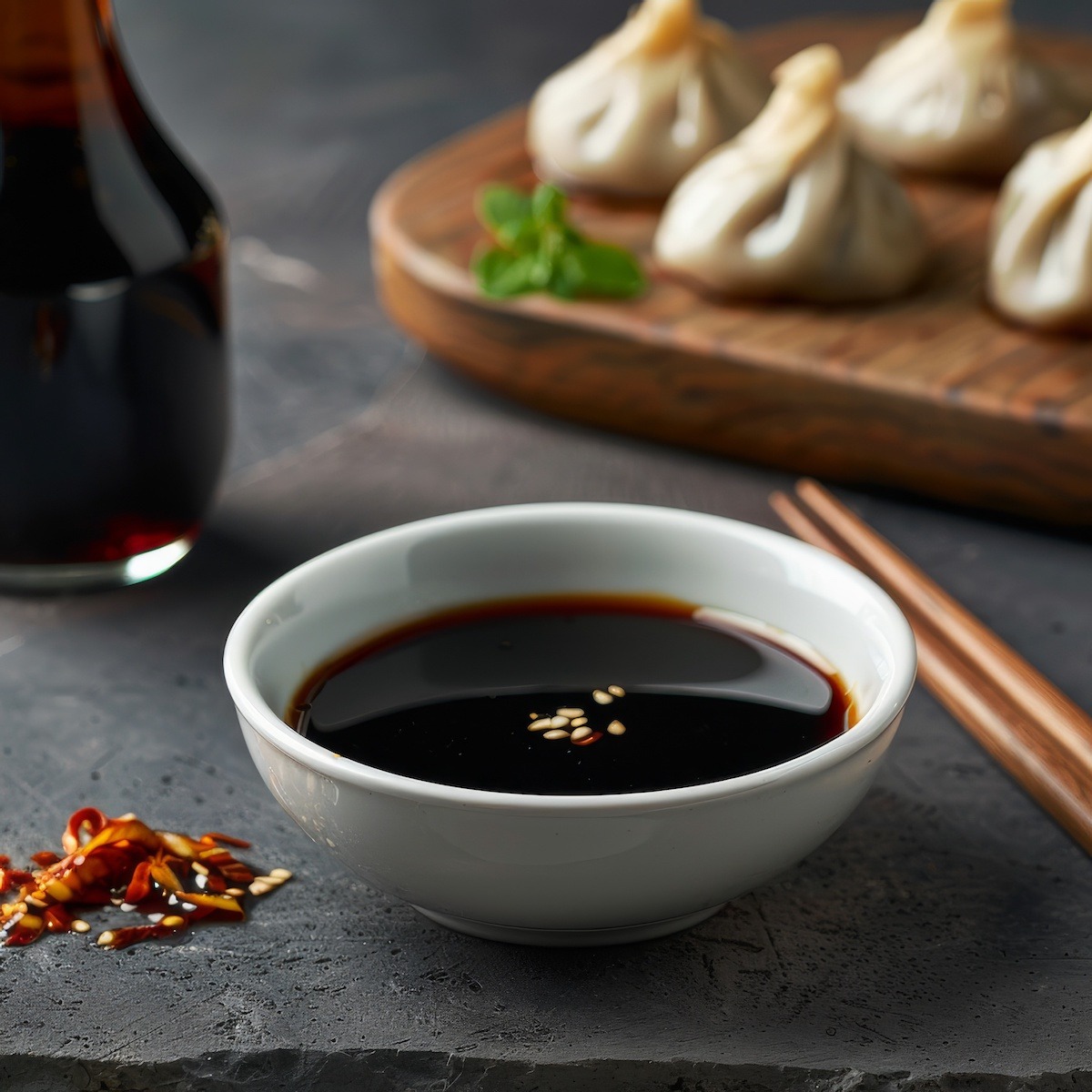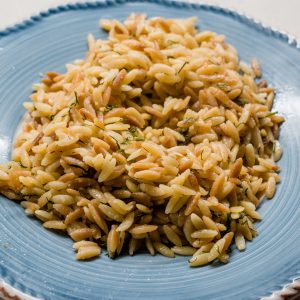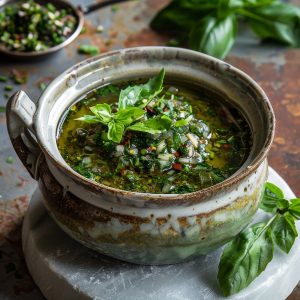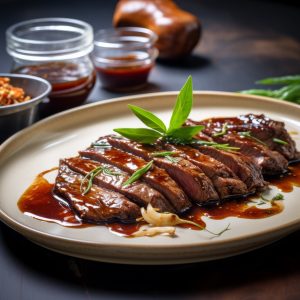Soy Ginger Sauce
Soy ginger sauce is a delightful and versatile condiment that brings a burst of flavor to various dishes. This sauce, rooted in Asian culinary traditions, is beloved for its harmonious blend of salty, sweet, tangy, and slightly spicy notes. The main ingredients—soy sauce and fresh ginger—create a robust foundation, while additional elements like garlic, honey, and rice vinegar add depth and complexity.
Perfect for marinades, stir-fries, dipping sauces, and dressings, soy ginger sauce enhances the taste of meats, vegetables, and even tofu. Its umami-rich profile pairs beautifully with the zingy heat of ginger, making it an excellent companion for grilled chicken, seared fish, or steamed dumplings. Moreover, the sauce is simple to prepare, requiring just a handful of ingredients and minimal cooking time, making it an easy addition to your culinary repertoire.
Whether you are an experienced cook or a kitchen novice, mastering this soy ginger sauce recipe will elevate your dishes, bringing a taste of the Far East to your dining table. So, gather your ingredients, embrace the art of sauce-making, and get ready to impress your family and friends with this exquisite and multifaceted condiment.
More About Soy Ginger Sauce
Here are some additional insights and tips to maximize your use and enjoyment of this sauce:
- Health Benefits: Ginger is renowned for its anti-inflammatory and digestive benefits, while soy sauce provides a good source of umami, which can reduce the need for additional salt. Opting for low-sodium soy sauce can make this sauce even healthier.
- Customizations: Feel free to tweak the ingredients to match your taste. For a sweeter profile, add more honey or brown sugar. For extra heat, include a dash of chili flakes or sriracha. Adding citrus juice like lime or lemon can brighten the sauce.
- Storage: Soy ginger sauce is well-suited for refrigerator storage. Make a larger batch and store it in an airtight container for up to two weeks. This way, you’ll always have a tasty dressing or marinade on hand.
- Usage Ideas: In addition to the usual applications, try drizzling the sauce over roasted vegetables, mixing it into noodles or rice dishes, or using it as a base for an Asian-inspired salad dressing. It can also be a fantastic glaze for meats or tofu, especially when reduced slightly to thicken.
- Allergy Considerations: Tamari or coconut aminos are excellent substitutes for soy allergies, offering similar flavors. If preparing for someone with gluten sensitivities, ensure all ingredients are gluten-free.
- Cultural Context: Soy ginger sauce is a staple in various Asian cuisines, notably Chinese, Japanese, and Korean. Understanding its cultural roots can enhance your appreciation and inspire more authentic uses in your cooking.
History of Soy Ginger Sauce
The history of soy ginger sauce traces back to the rich culinary traditions of East Asia, particularly China and Japan. Soy sauce, a key ingredient in this sauce, has roots dating back over 2,000 years, originating in China during the Zhou Dynasty. Initially known as Jiang (醬), it evolved over centuries, with fermented soybeans becoming the primary ingredient. Ginger, a ubiquitous spice in Asian cooking, has also been used for thousands of years, prized for its flavor and medicinal properties.
The fusion of soy sauce and ginger likely emerged as cooks experimented with combining local ingredients to create flavorful sauces and marinades. Over time, this combination gained popularity across Asia, with each region adding its twist to the recipe. The resulting sauce became a staple in Asian households, cherished for its versatility and ability to enhance a wide range of dishes.
While the exact origin of soy ginger sauce is difficult to pinpoint, its widespread use in Asian cuisine suggests a long history of adaptation and innovation. Today, soy ginger sauce continues to be a beloved condiment and marinade, enjoyed in both traditional and contemporary dishes worldwide, reflecting the enduring legacy of ancient culinary traditions.

Ingredients
Soy Sauce
Soy sauce, a staple condiment in Asian cuisine, boasts a centuries-old legacy of flavor and tradition. Crafted from fermented soybeans, wheat, salt, and sometimes other grains, it undergoes a meticulous aging process, yielding its iconic umami-rich taste.
With its deep, savory notes and subtle hints of sweetness, soy sauce enhances the complexity of dishes, from stir-fries to marinades and beyond. Its versatility extends to dipping sauces, dressings, and seasoning, making it indispensable in kitchens worldwide. Beyond its culinary prowess, soy sauce also offers nutritional benefits, containing essential amino acids and minerals, adding flavor and nourishment to meals.
Ginger Root
Ginger root, commonly referred to as ginger, is a rhizome of the plant Zingiber officinale, belonging to the family Zingiberaceae. This knobby, fibrous root is well-known for its pungent, spicy flavor and aromatic qualities, making it a staple in many culinary traditions worldwide. Here’s more about ginger root:
Characteristics:
- Appearance: Fresh ginger root has rough, beige, or light brown skin that can be easily peeled. The interior flesh, depending on the variety, ranges from pale yellow to white or even red.
- Texture: It is firm and fibrous, with a slightly juicy consistency when fresh.
- Flavor: The taste of ginger is distinctively sharp and spicy, with a hint of sweetness and warmth. It also has a fragrant aroma that is both peppery and citrusy.
Culinary Uses:
- Fresh Ginger: Sliced, chopped, grated, or minced, it adds a fresh, zesty flavor to dishes. It’s used in stir-fries, soups, curries, and marinades.
- Dried Ginger: Ground-dried ginger is commonly used in baking, spice mixes, and some savory dishes.
- Preserved Ginger: Includes crystallized (candied) ginger, pickled ginger (gari, commonly served with sushi), and ginger paste.
Health Benefits:
- Digestive Aid: Ginger is widely known for its ability to soothe the digestive system and relieve nausea.
- Anti-Inflammatory: Contains gingerol, a bioactive compound with powerful anti-inflammatory and antioxidant properties.
- Cold Remedy: Often used in teas and home remedies to alleviate cold and flu symptoms.
Storage:
- Fresh Ginger: Can be stored in the refrigerator for several weeks, wrapped in a paper towel and placed in a plastic bag. For longer storage, it can be frozen.
- Dried Ginger: Should be kept in a cool, dry place in an airtight container.
Sesame Oil
Sesame oil, revered for millennia in Asian cuisine, exudes a distinct nutty aroma and rich flavor that elevates dishes with sophistication. Extracted from sesame seeds, this golden elixir boasts a high smoke point, making it ideal for sautéing, frying, and stir-frying without overpowering the palate.
Its nuanced taste ranges from mild and sweet in toasted varieties to bold and robust in untoasted forms, imparting depth to marinades, dressings, and dipping sauces. Beyond its culinary prowess, sesame oil offers health benefits, containing antioxidants and healthy fats that contribute to heart health and overall well-being, embodying a fusion of flavor and nourishment.
Soy Ginger Sauce
Ingredients
- ¼ cup soy sauce
- ¼ cup balsamic vinegar
- 2 tablespoons water
- 1 tablespoon ginger root minced
Instructions
- Peel and julienne the ginger root.
- In a small mixing bowl, combine all the ingredients.
Notes
Alternative Recipe
This is another way to prepare it, and I love what the sesame oil adds to the sauce.
Soy Ginger Sauce Recipe
Ingredients
- ¼ cup soy sauce low sodium if preferred
- 2 tablespoons rice vinegar
- 1 tablespoon fresh ginger
- 2 cloves garlic minced
- 1 tablespoon honey or brown sugar (adjust to taste)
- 1 teaspoon sesame oil
- 1 tablespoon green onion or cilantro finely chopped for garnish
Instructions
- In a small bowl, whisk together the soy sauce, rice vinegar, grated ginger, minced garlic, honey or brown sugar, and sesame oil until well combined. Add more honey/sugar or soy sauce to adjust the sweetness and saltiness according to your taste preferences if needed.
- Taste the sauce and adjust the seasoning if necessary. You can add more grated ginger if you prefer a more robust ginger flavor.
- Once the sauce is well mixed and seasoned to your liking, let it sit for about 10-15 minutes to allow the flavors to meld together.
- Before using, give the sauce a final stir to ensure all the ingredients are evenly distributed.
- Use the soy ginger sauce as a marinade for chicken, beef, seafood, tofu, or vegetables. You can also use it as a stir-fry sauce or a dipping sauce for sushi, dumplings, or spring rolls.
- If desired, garnish with finely chopped green onions or cilantro before serving for an extra burst of freshness.

















